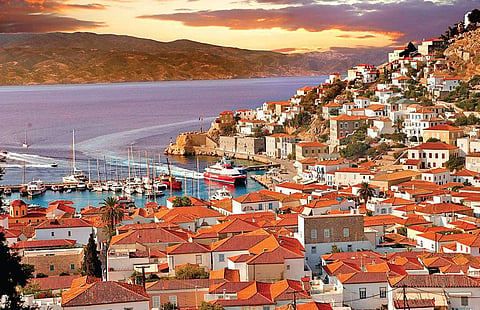

"Beauty rises up to greet me. The sea lies waiting, the port promises drama, the rocks clang with bells from the island’s many churches." It is 1960, and 17-year-old Erica’s mother has recently passed away. Before dying, her mother leaves her a thousand pounds and tells her that the world is her oyster and that she should have some adventures and dare to dream. Erica reads a copy of a book that has been mailed by her mother’s closest friend, Australian writer and essayist Charmian Clift, who lives in the Greek island of Hydra. She gets lost in the pages of the book about Charmian’s incredible life and her family’s first year on the island, complete with its sunny days, crescent harbour and moonlight swims in the glittering sea.
Erica and her brother Bobby decide to go to Greece for a year. They are accompanied by two other friends and 21-year-old Jimmy Jones, Erica’s first love, who after dropping out of law school, spends his time painting and writing poetry in his studio. The five of them make the journey from London to Greece in a car, crossing France and Italy on the way.
English novelist, lyricist and journalist Polly Samson sprinkles the book with several delicious descriptions that instantly transport the reader to this dreamy Greek island—truly “a theatre for dreamers”—“The black sea is squiggled from mast lights, silvered with stars, spangled green and red from the harbour beacons. A bright gibbous moon rises from the mountains; the cicadas pour their love songs from the trees.” The island has been home to lots of dishevelled and miserable writers, artists, poets and musicians at some point or the other. After seeing it for herself, Erica realises why it’s not hard to imagine that several people are lured by its “fantastically blue water and cheap rent to live out their carefree immorality away from prying city eyes.” Further, she finds that the islanders speak a language of their own, and the wine here is cheaper than lemonade.
On reaching the Promised Land of her dreams, Erica meets Charmian and her husband—Australian journalist, war correspondent and novelist George Johnston. The couple are in a state of creative disarray—as George is in the middle of writing his tortuous novel. But she soon finds that not all is hunky dory as it seems, and the island comes with its share of dramas. For the people who live here, life is not as easy, particularly for the female muses of the artists and writers.
The women are “all cooped up in their houses and servile to their men”, and of course, there is the daily grind of finding food and carrying water. Charmian and George often fight with each other, and Norwegian author Axel Jensen is fooling around with a Canadian girl, Patricia, while his wife Marianne Ihlen is away having a baby in Oslo. Shortly after Marianne returns to the island with the baby, Axel leaves with Patricia and meets with an accident. It turns out to be an experience, signifying coming-of-age and innocence lost for young Erica, who witnesses Marianne gradually becoming a muse for Canadian singer songwriter Leonard Cohen.
“Was it drugs and contraception that made change seem possible? Was it a conscious revolution? Or were we simply children who craved languor and sex and mind alteration to ease the anxiety that was etched into our DNA, detonating in each of our young brains its own private Hiroshima?” Reading the book is like taking a peek into the hedonistic lifestyle of a beautiful and confused bygone era. Numerous images of Woodstock ’69—that bohemian summer of love—its “hippie trails” and drugs, instantly flood your mind’s eye. In short, the perfect book to escape and lose oneself into, particularly for a time when there’s no travel.
Reading the book is like taking a peek into the hedonistic lifestyle of a beautiful and confused bygone era. Numerous images of Woodstock ’69—that bohemian summer of love.